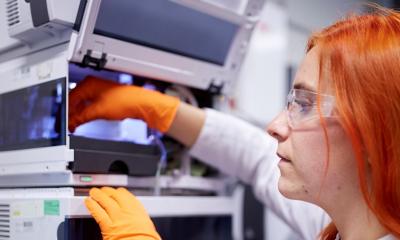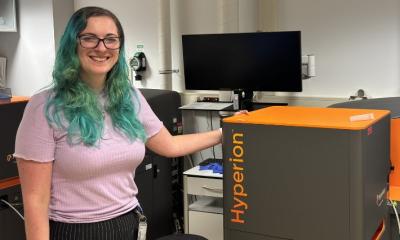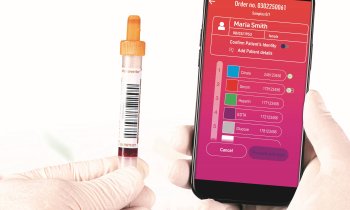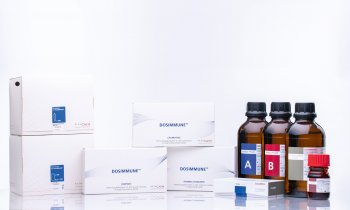Article • Mass spectrometry analysis
Skin swabs can detect Covid-19
Skin swab samples analysed using mass spectrometry could be used to detect Covid-19 in patients, according to research conducted at the University of Surrey in the UK.
Report: Mark Nicholls
Current Covid-19 testing is via a polymerase chain reaction (PCR) test, which involves taking a swab of the back of the throat and inside the nose, but the team from Surrey - working with Frimley NHS Trust and the Universities of Manchester and Leicester - have used sebum samples from the outer layers of skin (stratum corneum) to identify the presence of Covid-19. They collected samples from 67 hospitalised patients - 30 who had tested positive for Covid-19 and 37 who had tested negative – by swabbing skin between the shoulder blades. It is an area of the body which is rich in sebum, the oily, waxy substance produced by sebaceous glands.

Samples were then analysed using liquid chromatography (to separate the lipids) and mass spectrometry (to identify the lipids). The Partial Least Squares Discriminant Analysis (PLSDA) statistical modelling technique was used to differentiate between the Covid-19 positive and negative samples. Patients with a positive Covid-19 test had lower lipid levels - or dyslipidemia - than those with a negative test.
Study co-author Matt Spick said: “The test differentiates between positive and negative Covid-19 results by looking at sebum lipids in the outer layer of skin. We found that participants infected with Covid-19 had markedly reduced levels of many triglycerides and ceramides in particular. Although no single lipid gave a definitive signal, by looking at the overall lipid profile through multivariate machine learning, we could differentiate between positive and negative results.”
The team believe sebum sampling has the potential to support diagnosis and prognosis, as well as for investigation into the impact of Covid-19 on the host metabolism, by looking at what the virus does to patients, rather than looking for the virus itself.

A challenge faced by researchers was that comorbidities also dysregulate the skin, making it difficult to differentiate between Covid effects and conditions such as Type 2 Diabetes. However, this was addressed with medication and additional health conditions factored in. “We controlled for this by matching comorbidities,” added Mr Spick, “for example, looking at the difference between Covid-19 positive and negative within the subgroup of participants with T2DM. We found that when controlled for comorbidities our model was 82% accurate.”
In addition, with thousands of different lipids present in the human body, differentiating between them proved a further challenge. However, co-author Dr Melanie Bailey explained: “Mass spectrometry lets us identify the individual lipids, both by accurate molecular mass and also by breaking the molecule apart and identifying characteristic fragmentation patterns.”
PCR remains the gold standard in Covid testing in terms of accuracy, and there is no suggestion that sebum-based tests can replace them, but researchers believe sebum swabs may provide an alternative, although they acknowledge the test is not yet suited to clinical settings. At present they think the work is more likely to inform research into skin health and how it is influenced by infection.
Understanding how diseases interact with other comorbidities in influencing the metabolism of the stratum corneum can only help our understanding of skin health
Melanie Bailey
Dr Bailey said: “The most obvious implication of our findings is that skin can be added to the list of organs that are dysregulated by Covid. Another feature of Covid-19 is the range of symptoms that those infected may present with. We do not yet fully understand how this variation might translate to skin, but it does appear that the reduction in sebum triglyceride and ceramide levels is a consistent feature across the population that we sampled. More broadly, understanding how diseases interact with other comorbidities in influencing the metabolism of the stratum corneum can only help our understanding of skin health.”
The work is one strand of research into skin health as a diagnostic tool, with work at the University of Manchester, for example, looking at how sebum sampling followed by mass spectrometry can be used to diagnose Parkinson’s Disease. Because the skin is so rich in lipids, and also because sebum is non-invasive and quick to sample – and can be sampled in a home setting – the Surrey team believe the method shows promise for diagnostics and monitoring of Covid-19. “Our study suggests that we may be able to use non-invasive means to test for diseases such as Covid-19 in the future,” added Dr Bailey.
Profiles:
Dr Melanie Bailey is a Reader in Chemistry at the University of Surrey, and is currently working on an EPSRC funded fellowship. Matt Spick is a Post-Graduate Researcher at the University of Surrey within the Bailey research group.
01.04.2021











